Conics
Parabolas
Learning Objectives
By the end of this section, you will be able to:
- Graph vertical parabolas
- Graph horizontal parabolas
- Solve applications with parabolas
Before you get started, take this readiness quiz.
Graph Vertical Parabolas
The next conic section we will look at is a parabola. We define a parabola as all points in a plane that are the same distance from a fixed point and a fixed line. The fixed point is called the focus, and the fixed line is called the directrix of the parabola.

A parabola is all points in a plane that are the same distance from a fixed point and a fixed line. The fixed point is called the focus, and the fixed line is called the directrix of the parabola.
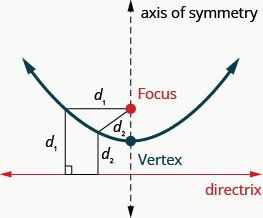
Previously, we learned to graph vertical parabolas from the general form or the standard form using properties. Those methods will also work here. We will summarize the properties here.
| Vertical Parabolas | ||
|---|---|---|
| General form |
Standard form |
|
| Orientation | ||
| Axis of symmetry | ||
| Vertex | Substitute solve for y. |
|
| y-intercept | Let |
Let |
| x-intercepts | Let |
Let |
The graphs show what the parabolas look like when they open up or down. Their position in relation to the x– or y-axis is merely an example.
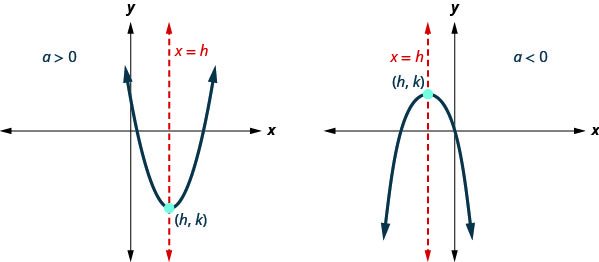
To graph a parabola from these forms, we used the following steps.
- Determine whether the parabola opens upward or downward.
- Find the axis of symmetry.
- Find the vertex.
- Find the y-intercept. Find the point symmetric to the y-intercept across the axis of symmetry.
- Find the x-intercepts.
- Graph the parabola.
The next example reviews the method of graphing a parabola from the general form of its equation.
Graph ![]() by using properties.
by using properties.
 |
|
| Since a is |
|
 |
|
| To find the axis of symmetry, find |
 |
 |
|
 |
|
| The axis of symmetry is |
|
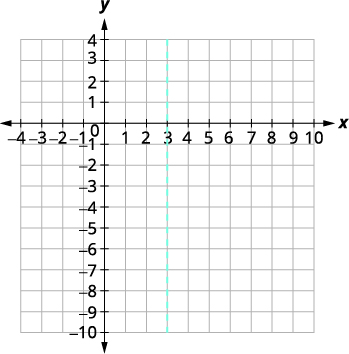 |
|
| The vertex is on the line |
 |
| Let |
 |
 |
|
 |
|
| The vertex is |
|
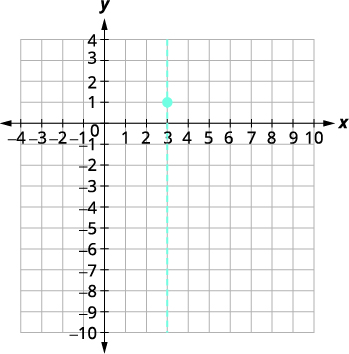 |
|
| The y-intercept occurs when |
 |
| Substitute |
 |
| Simplify. |  |
| The y-intercept is |
|
| The point line of symmetry. The point three units to the right of the line of symmetry is |
Point symmetric to the y-intercept is |
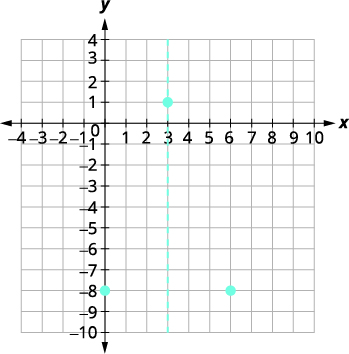 |
|
| The x-intercept occurs when |
 |
| Let |
 |
| Factor the GCF. |  |
| Factor the trinomial. |  |
| Solve for x. |  |
| The x-intercepts are |
|
| Graph the parabola. | 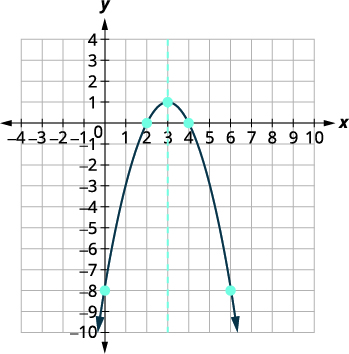 |
Graph ![]() by using properties.
by using properties.
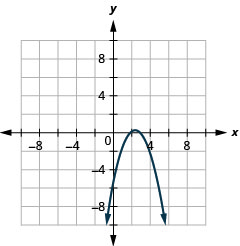
Graph ![]() by using properties.
by using properties.

The next example reviews the method of graphing a parabola from the standard form of its equation, ![]()
Write![]() in standard form and then use properties of standard form to graph the equation.
in standard form and then use properties of standard form to graph the equation.
| Rewrite the function in by completing the square. |
|
| Identify the constants a, h, k. | |
| Since |
|
 |
|
| The axis of symmetry is |
The axis of symmetry is |
| The vertex is |
The vertex is |
| Find the y-intercept by substituting |
|
| y-intercept |
|
| Find the point symmetric to |
|
| Find the x-intercepts. | 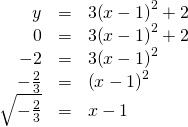 |
| The square root of a negative number tells us the solutions are complex numbers. So there are no x-intercepts. |
|
| Graph the parabola. | 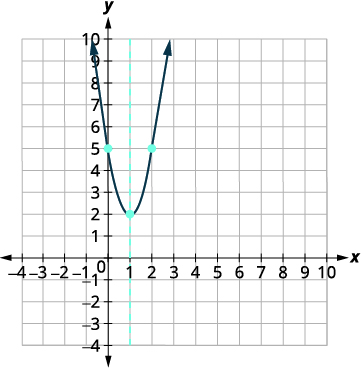 |
ⓐ Write ![]() in standard form and ⓑ use properties of standard form to graph the equation.
in standard form and ⓑ use properties of standard form to graph the equation.
ⓐ![]()
ⓑ
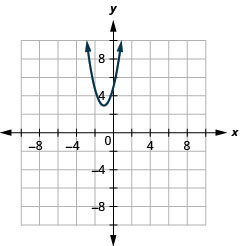
ⓐ Write ![]() in standard form and ⓑ use properties of standard form to graph the equation.
in standard form and ⓑ use properties of standard form to graph the equation.
ⓐ![]()
ⓑ
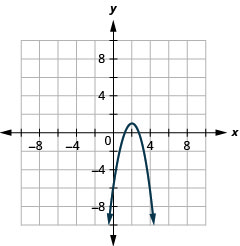
Graph Horizontal Parabolas
Our work so far has only dealt with parabolas that open up or down. We are now going to look at horizontal parabolas. These parabolas open either to the left or to the right. If we interchange the x and y in our previous equations for parabolas, we get the equations for the parabolas that open to the left or to the right.
| Horizontal Parabolas | ||
|---|---|---|
| General form |
Standard form |
|
| Orientation | ||
| Axis of symmetry | ||
| Vertex | Substitute solve for x. |
|
| y-intercepts | Let |
Let |
| x-intercept | Let |
Let |
The graphs show what the parabolas look like when they to the left or to the right. Their position in relation to the x– or y-axis is merely an example.
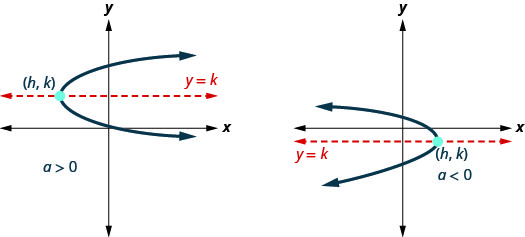
Looking at these parabolas, do their graphs represent a function? Since both graphs would fail the vertical line test, they do not represent a function.
To graph a parabola that opens to the left or to the right is basically the same as what we did for parabolas that open up or down, with the reversal of the x and y variables.
- Determine whether the parabola opens to the left or to the right.
- Find the axis of symmetry.
- Find the vertex.
- Find the x-intercept. Find the point symmetric to the x-intercept across the axis of symmetry.
- Find the y-intercepts.
- Graph the parabola.
Graph ![]() by using properties.
by using properties.
 |
|
| Since |
|
 |
|
| To find the axis of symmetry, find |
 |
 |
|
 |
|
| The axis of symmetry is |
|
| The vertex is on the line |
 |
| Let |
 |
 |
|
| The vertex is |
Since the vertex is ![]() both the x– and y-intercepts are the point
both the x– and y-intercepts are the point ![]() To graph the parabola we need more points. In this case it is easiest to choose values of y.
To graph the parabola we need more points. In this case it is easiest to choose values of y.

We also plot the points symmetric to ![]() and
and ![]() across the y-axis, the points
across the y-axis, the points ![]()
![]()
Graph the parabola.
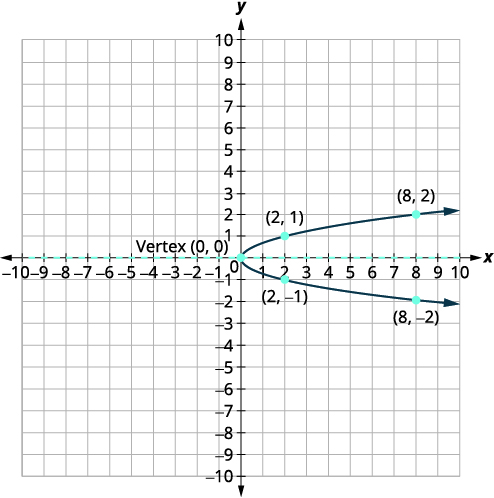
Graph ![]() by using properties.
by using properties.
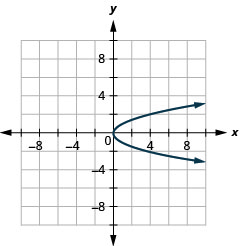
Graph ![]() by using properties.
by using properties.
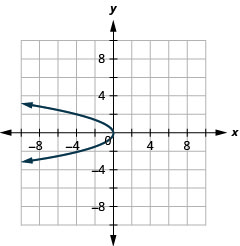
In the next example, the vertex is not the origin.
Graph ![]() by using properties.
by using properties.
 |
|
| Since |
|
 |
|
| To find the axis of symmetry, find |
 |
 |
|
 |
|
| The axis of symmetry is |
|
| The vertex is on the line |
 |
| Let |
 |
 |
|
| The vertex is |
|
| The x-intercept occurs when |
 |
 |
|
 |
|
| The x-intercept is |
|
| The point symmetry. The symmetric point one unit above the line of symmetry is |
Symmetric point is |
| The y-intercept occurs when |
 |
| Substitute |
 |
| Solve. |  |
 |
|
 |
|
| The y-intercepts are |
|
| Connect the points to graph the parabola. | 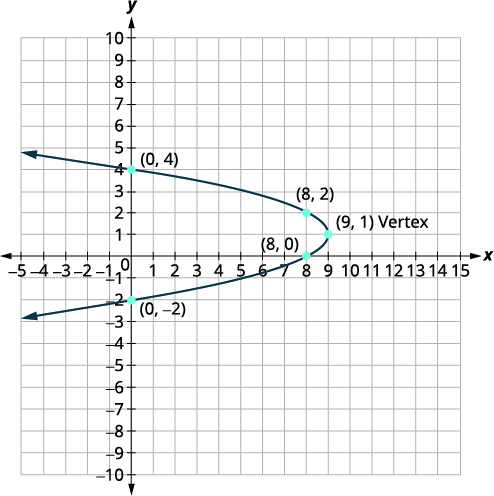 |
Graph ![]() by using properties.
by using properties.
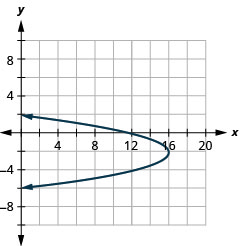
Graph ![]() by using properties.
by using properties.
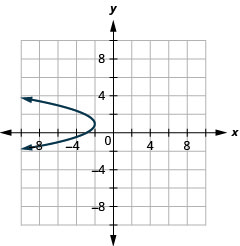
In (Figure), we see the relationship between the equation in standard form and the properties of the parabola. The How To box lists the steps for graphing a parabola in the standard form ![]() We will use this procedure in the next example.
We will use this procedure in the next example.
Graph ![]() using properties.
using properties.
 |
|
| Identify the constants a, h, k. | |
| Since |
|
 |
|
| The axis of symmetry is |
|
| The vertex is |
|
| Find the x-intercept by substituting |
 |
| Find the point symmetric to axis of symmetry. |
|
| Find the y-intercepts. Let |
 |
| A square cannot be negative, so there is no real solution. So there are no y-intercepts. |
|
| Graph the parabola. | 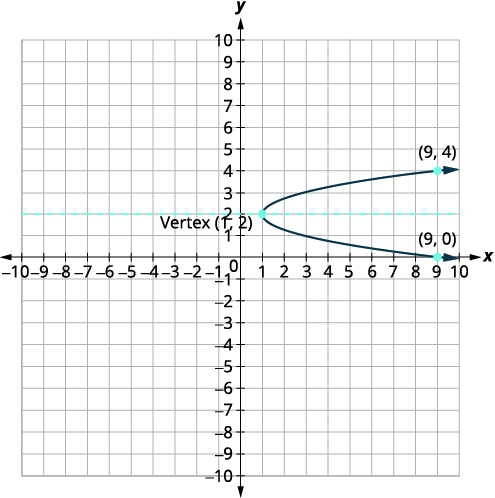 |
Graph ![]() using properties.
using properties.
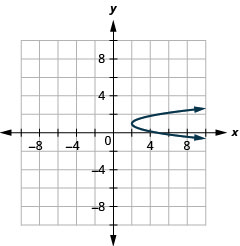
Graph ![]() using properties.
using properties.
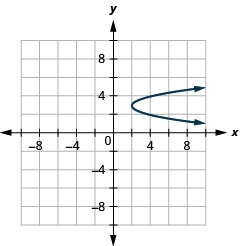
In the next example, we notice the a is negative and so the parabola opens to the left.
Graph ![]() using properties.
using properties.
 |
|
| Identify the constants a, h, k. | |
| Since |
|
 |
|
| The axis of symmetry is |
|
| The vertex is |
|
| Find the x-intercept by substituting |
 |
| Find the point symmetric to axis of symmetry. |
|
| Find the y-intercepts. | |
| Let |
 |
| The y-intercepts are |
|
| Graph the parabola. | 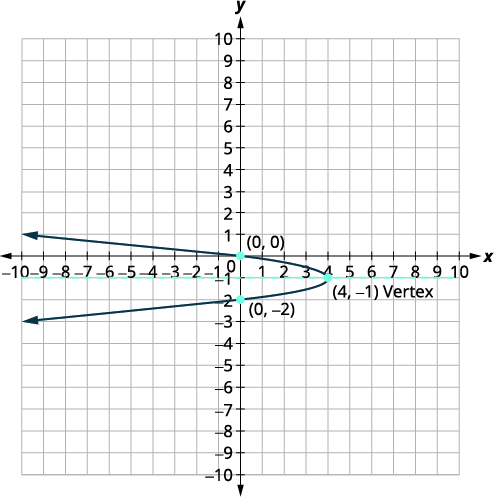 |
Graph ![]() using properties.
using properties.
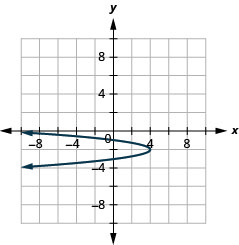
Graph ![]() using properties.
using properties.
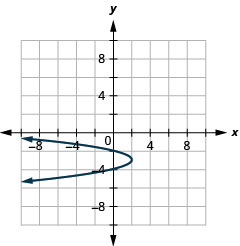
The next example requires that we first put the equation in standard form and then use the properties.
Write ![]() in standard form and then use the properties of the standard form to graph the equation.
in standard form and then use the properties of the standard form to graph the equation.
 |
|
| Rewrite the function in the square. |
 |
 |
|
 |
|
 |
|
| Identify the constants a, h, k. | |
| Since the right. |
|
 |
|
| The axis of symmetry is |
|
| The vertex is |
|
| Find the x-intercept by substituting |
 |
| Find the point symmetric to across the axis of symmetry. |
|
| Find the y-intercepts. Let |
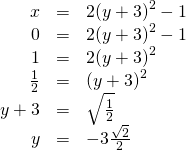 |
| The y-intercepts are |
|
| Graph the parabola. | 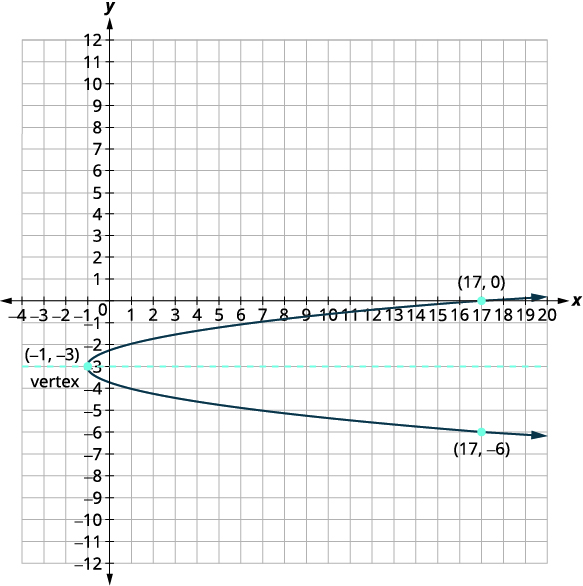 |
ⓐ Write ![]() in standard form and ⓑ use properties of the standard form to graph the equation.
in standard form and ⓑ use properties of the standard form to graph the equation.
ⓐ![]()
ⓑ
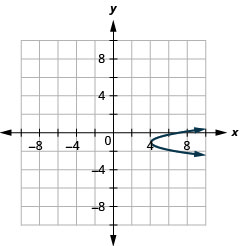
ⓐ Write ![]() in standard form and ⓑ use properties of the standard form to graph the equation.
in standard form and ⓑ use properties of the standard form to graph the equation.
ⓐ![]()
ⓑ
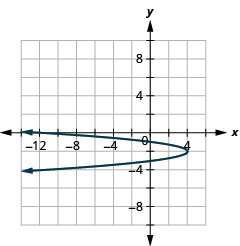
Solve Applications with Parabolas
Many architectural designs incorporate parabolas. It is not uncommon for bridges to be constructed using parabolas as we will see in the next example.
Find the equation of the parabolic arch formed in the foundation of the bridge shown. Write the equation in standard form.

We will first set up a coordinate system and draw the parabola. The graph will give us the information we need to write the equation of the graph in the standard form![]()
| Let the lower left side of the bridge be the origin of the coordinate grid at the point Since the base is 20 feet wide the point The bridge is 10 feet high at the highest point. The highest point is the vertex of the parabola so the y-coordinate of the vertex will be 10. Since the bridge is symmetric, the vertex must fall halfway between the left most point, x-coordinate of the vertex will also be 10. |
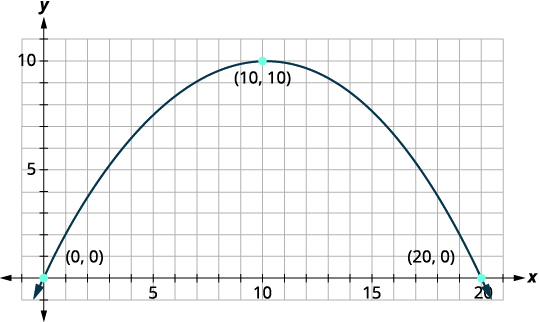 |
| Identify the vertex, |
|
| Substitute the values into the standard form. The value of a is still unknown. To find the value of a use one of the other points on the parabola. |
 |
| Substitute the values of the other point into the equation. |
|
| Solve for a. | 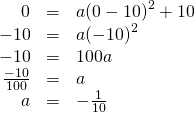 |
| Substitute the value for a into the equation. |
Find the equation of the parabolic arch formed in the foundation of the bridge shown. Write the equation in standard form.

![]()
Find the equation of the parabolic arch formed in the foundation of the bridge shown. Write the equation in standard form.

![]()
![]()
Access these online resources for additional instructions and practice with quadratic functions and parabolas.
Key Concepts
- Parabola: A parabola is all points in a plane that are the same distance from a fixed point and a fixed line. The fixed point is called the focus, and the fixed line is called the directrix of the parabola.
Vertical Parabolas General form 
Standard form 
Orientation  up;
up;  down
down up;
up;  down
downAxis of symmetry 

Vertex Substitute  and
and
solve for y.
y– intercept Let 
Let 
x-intercepts Let 
Let 
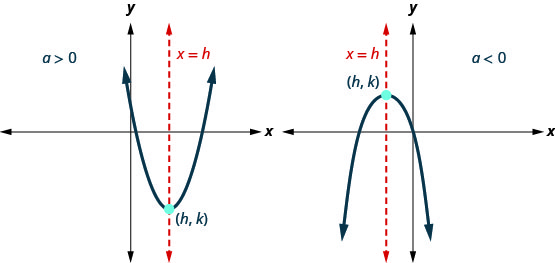
- How to graph vertical parabolas
 or
or  using properties.
using properties.
- Determine whether the parabola opens upward or downward.
- Find the axis of symmetry.
- Find the vertex.
- Find the y-intercept. Find the point symmetric to the y-intercept across the axis of symmetry.
- Find the x-intercepts.
- Graph the parabola.
Horizontal Parabolas General form 
Standard form 
Orientation  right;
right;  left
left right;
right;  left
leftAxis of symmetry 

Vertex Substitute  and
and
solve for x.
y-intercepts Let 
Let 
x-intercept Let 
Let 
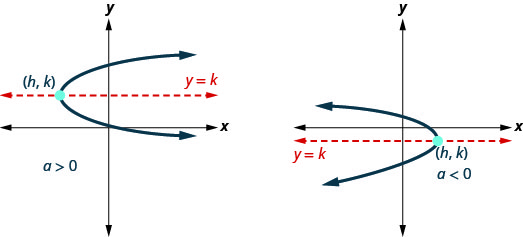
- How to graph horizontal parabolas
 or
or  using properties.
using properties.
- Determine whether the parabola opens to the left or to the right.
- Find the axis of symmetry.
- Find the vertex.
- Find the x-intercept. Find the point symmetric to the x-intercept across the axis of symmetry.
- Find the y-intercepts.
- Graph the parabola.
Practice Makes Perfect
Graph Vertical Parabolas
In the following exercises, graph each equation by using properties.
![]()
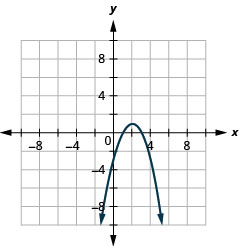
![]()
![]()
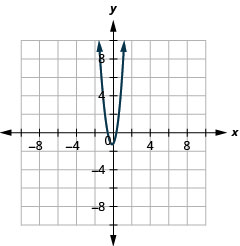
![]()
In the following exercises, ⓐ write the equation in standard form and ⓑ use properties of the standard form to graph the equation.
![]()
ⓐ![]()
ⓑ
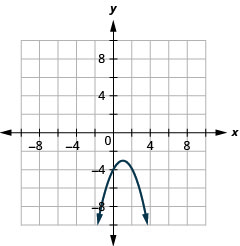
![]()
![]()
ⓐ![]()
ⓑ
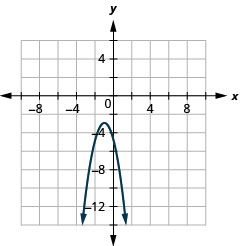
![]()
Graph Horizontal Parabolas
In the following exercises, graph each equation by using properties.
![]()
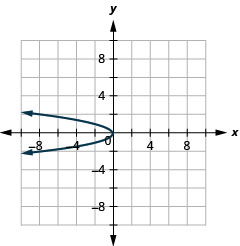
![]()
![]()
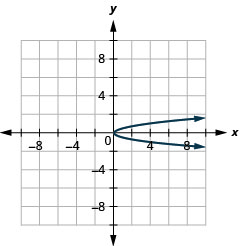
![]()
![]()
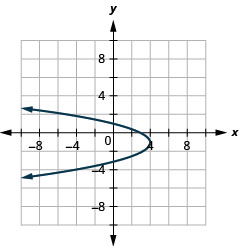
![]()
![]()
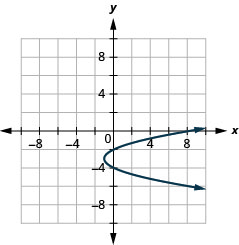
![]()
![]()
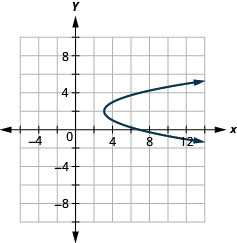
![]()
![]()
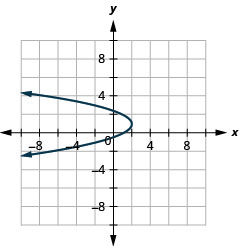
![]()
![]()
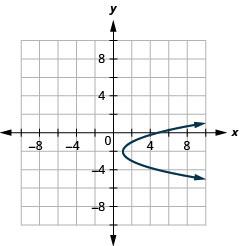
![]()
![]()
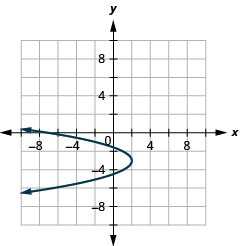
![]()
![]()
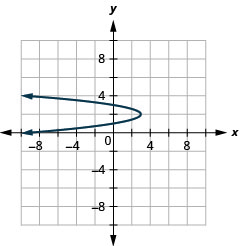
![]()
![]()
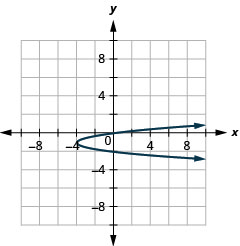
![]()
In the following exercises, ⓐ write the equation in standard form and ⓑ use properties of the standard form to graph the equation.
![]()
ⓐ![]()
ⓑ
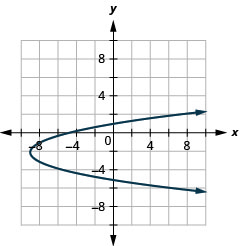
![]()
![]()
ⓐ![]()
ⓑ
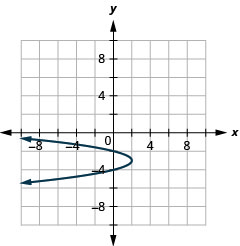
![]()
Mixed Practice
In the following exercises, match each graph to one of the following equations: ⓐ x2 + y2 = 64 ⓑ x2 + y2 = 49
ⓒ (x + 5)2 + (y + 2)2 = 4 ⓓ (x − 2)2 + (y − 3)2 = 9 ⓔ y = −x2 + 8x − 15 ⓕ y = 6x2 + 2x − 1
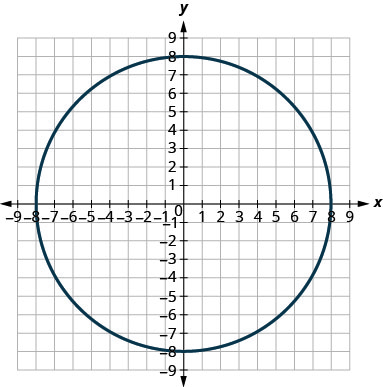
ⓐ
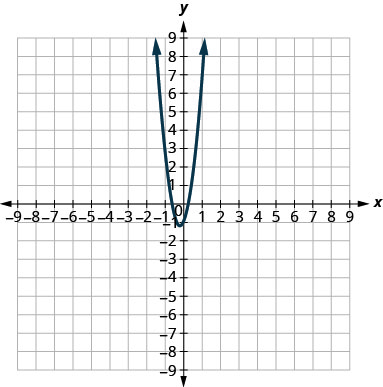
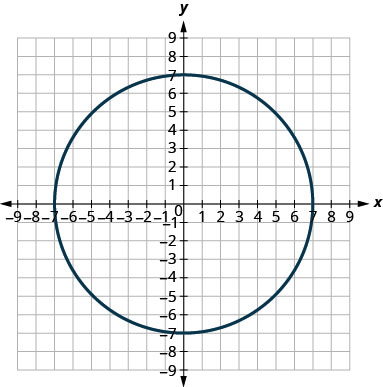
ⓑ
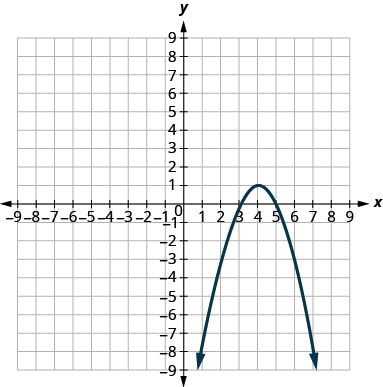
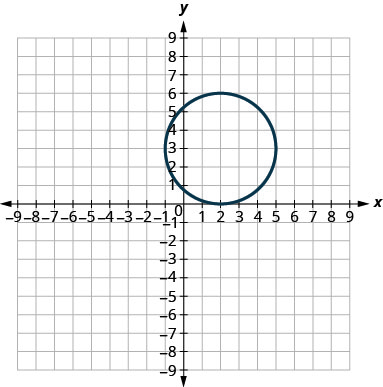
ⓓ
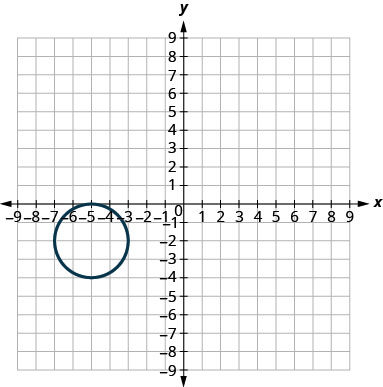
Solve Applications with Parabolas
Write the equation in standard form of the parabolic arch formed in the foundation of the bridge shown. Use the lower left side of the bridge as the origin (0, 0).

![]()
Write the equation in standard form of the parabolic arch formed in the foundation of the bridge shown. Use the lower left side of the bridge as the origin (0, 0).

Write the equation in standard form of the parabolic arch formed in the foundation of the bridge shown. Use the lower left side of the bridge as the origin (0, 0).

![]()
Write the equation in standard form of the parabolic arch formed in the foundation of the bridge shown. Use the lower left side of the bridge as the origin (0, 0).

Writing Exercises
In your own words, define a parabola.
Answers will vary.
Is the parabola ![]() a function? Is the parabola
a function? Is the parabola ![]() a function? Explain why or why not.
a function? Explain why or why not.
Write the equation of a parabola that opens up or down in standard form and the equation of a parabola that opens left or right in standard form. Provide a sketch of the parabola for each one, label the vertex and axis of symmetry.
Answers will vary.
Explain in your own words, how you can tell from its equation whether a parabola opens up, down, left or right.
Self Check
ⓐ After completing the exercises, use this checklist to evaluate your mastery of the objectives of this section.

ⓑ After reviewing this checklist, what will you do to become confident for all objectives?
Glossary
- parabola
- A parabola is all points in a plane that are the same distance from a fixed point and a fixed line.

